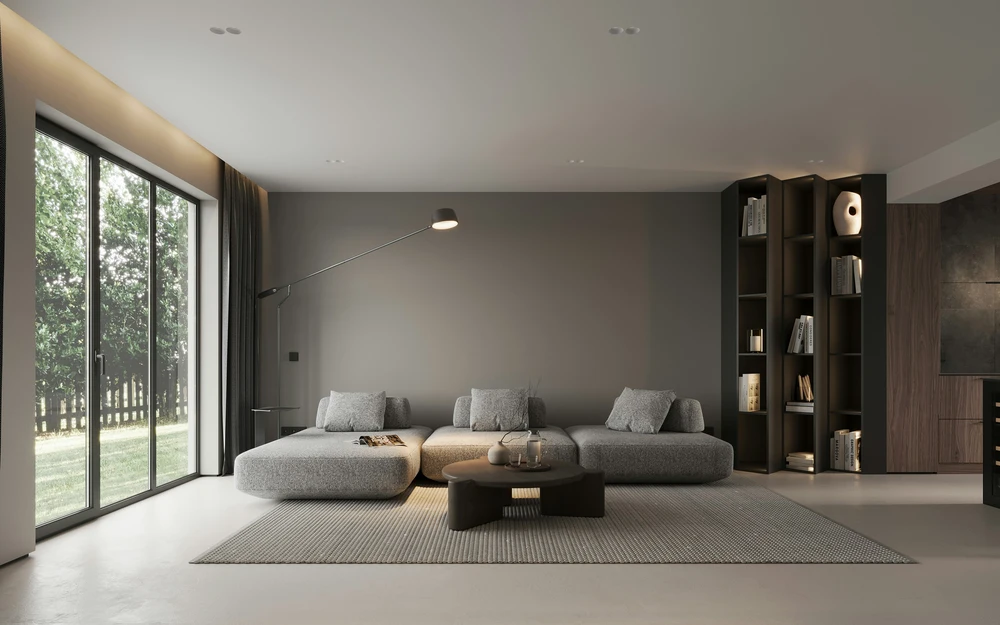Imagine walking into a room that adjusts itself before you touch a single control — the lights soften, your playlist fades in, and the air cools because the space knows what you’re thinking.
In 2025, this isn’t science fiction; it’s cognitive interior design.
AI-driven homes are moving beyond sensors and voice commands into the realm of mind-responsive architecture — spaces that interpret neural cues, gestures, and emotional micro-expressions to predict human intention.
Welcome to an era where design reads cognition, turning living environments into intuitive extensions of thought.

What Are Cognitive Interiors?
Cognitive interiors merge neuroscience, AI modeling, and responsive design systems. Using neural pattern mapping and context prediction algorithms, the environment decodes intent — not words.
Instead of asking Alexa to dim the lights, your living room perceives a drop in alpha brainwave activity and responds automatically.
This new frontier relies on:
- EEG-enabled wearables feeding data to edge-based AI hubs.
- Spatial behavior analytics tracking body language patterns.
- Context-learning engines combining emotion + time + activity history.
The outcome is a living interface — architecture that collaborates with your subconscious.
Why It Matters: From Convenience to Cognitive Interior Comfort
- Effortless Interaction – Removes friction between people and technology; actions become anticipatory.
- Emotional Wellness – Spaces sense stress and adapt light, scent, or temperature to calm the mind.
- Accessibility – Critical for users with limited mobility or speech impairments.
- Productivity Enhancement – Cognitive mapping aligns workspace lighting and sound to peak mental states.
- Design Empathy – Interiors become mirrors of human emotion, redefining comfort as connection.
Cognitive design shifts the question from “How should this space look?” to “How should this space understand me?”
The Technology Powering Cognitive Interior Design
- Neural-AI Bridges: Real-time EEG and fNIRS headbands transmit non-invasive brain activity.
- Emotion-Recognition Cameras: Identify micro-expressions invisible to the human eye.
- Predictive Pattern Engines: Forecast actions seconds before they occur.
- Ambient Computing Nodes: Distribute processing across furniture, lighting, and HVAC.
- Privacy-First Frameworks: Edge-based AI ensures data never leaves the home network.
Together, these systems create environments that evolve with your thought patterns — a mind-machine symbiosis through architecture.

Real-World Experiments Emerging in 2025
- NeuroNest Labs (Berlin): Prototype apartments trained on occupant EEG signatures.
- MIT SenseSpace Project: Uses thought-to-intent modeling to alter acoustic textures in real time.
- Panasonic MindRoom: Adaptive workspace lighting tied to team cognitive load metrics.
- Dyson CognitiveAir: Predicts respiratory comfort using stress-linked breathing rhythms.
These pilots prove that the next stage of smart homes isn’t control — it’s collaboration.
The Design Psychology Behind Thought-Responsive Spaces
Human cognition thrives on predictive stability. When environments anticipate needs, the brain releases dopamine, reinforcing comfort and trust.
Cognitive interiors leverage this psychology to create flow states — moments where thought, space, and behavior sync seamlessly.
Designers now talk about “empathic architecture”: aesthetics built not to impress the eye but to resonate with the mind.
Ethical Frontiers and Mental Privacy
With great intuition comes great responsibility.
If a room can read your thoughts, who owns that data?
Design ethics demand new frameworks:
- Consent Layers: Users choose when cognitive tracking activates.
- Local Encryption: Brainwave data stored only on personal devices.
- Transparency Dashboards: Real-time view of what’s being sensed and why.
Trust will define adoption — empathy must never become surveillance.
The Future: From Home to Collective Cognition
By 2027, cognitive AI could synchronize multiple occupants’ neural states, designing spaces that balance group emotion — ideal for hospitals, classrooms, or creative studios.
Imagine an office that senses collective fatigue and adjusts lighting spectrum to revive focus. Or a family home that mediates tension by softening ambient cues before arguments escalate.
The built environment will no longer be static. It will feel, learn, and think with us.

FAQs & Key Takeaways
Q1: Is cognitive interior design real or experimental?
Early prototypes exist; commercial rollout is expected within three years as EEG wearables miniaturize.
Q2: Does it invade privacy?
Edge-based AI ensures neural data remains encrypted locally — no cloud uploads required.
Q3: How accurate is thought prediction?
Current models achieve ~85% intent accuracy using multimodal signals (EEG + motion + context).
Q4: Can it help mental health?
Yes. Mood-adaptive environments have shown 20–30% reductions in stress biomarkers.
Key Takeaways
Cognitive interiors blend neuroscience with design to create spaces that think.
AI moves from reactive automation to proactive understanding.
Ethical transparency and consent will shape the trust between humans and intelligent environments.
As AI begins to listen to our thoughts instead of our words, design enters its most human phase yet — understanding without asking.
Discover more at Designs24hr.com — where intelligence meets imagination, one thought at a time.







